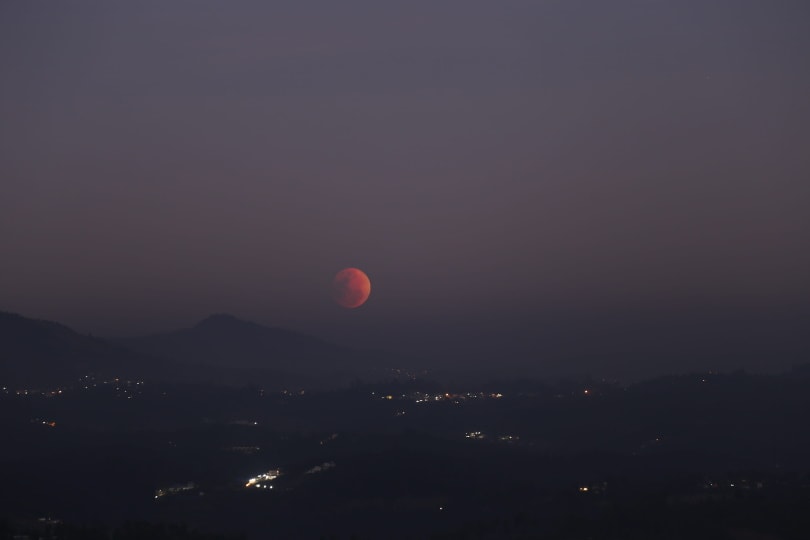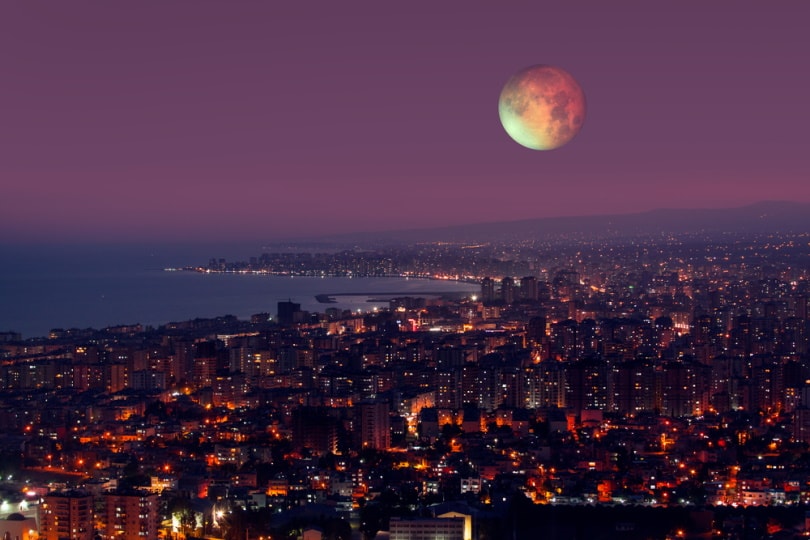Can I Look at a Lunar Eclipse? Is it Safe?
Last Updated on

If you know anything about a solar eclipse, you know that you cannot look directly at the eclipse without proper eye protection. If you do, you could severely damage your vision and eyes. What about a lunar eclipse? Can I look at a lunar eclipse?
Unlike a solar eclipse, it is completely safe to look directly at a lunar eclipse. Because you are only seeing the shadow of the Earth on the Moon, looking directly at a lunar eclipse will not damage your eyes, even if you do not have extra eye protection.
To learn more about how to safely look at a lunar eclipse and why it is different from looking at a solar eclipse, keep reading.

Is It Safe to Look at a Lunar Eclipse?
Unlike a solar eclipse, it is completely safe to look at a lunar eclipse with your naked eye. A lunar eclipse is no brighter than a regular full moon, which you’ve probably looked at plenty of times without any added protection. Needless to say, it is completely safe to look at a lunar eclipse without extra protection.

What Makes a Lunar Eclipse Different From a Solar Eclipse?
In order to fully understand why it is safe to look at a lunar eclipse, you have to understand what makes the lunar eclipse different from a solar eclipse.
Simply put, a lunar eclipse happens whenever the Earth is in between the Sun and the Moon, creating a shadow on the Moon. In comparison, a solar eclipse happens whenever the Moon is in between the earth and the Sun, creating a region of shadow on the Earth. So, how does this technicality make it dangerous to look at a solar eclipse but not a lunar eclipse?
With a solar eclipse, the Moon blocks the Sun and makes it appear less bright. However, the rays are still coming down and are just as dangerous as before. So, you’ll be able to comfortably look at the Sun during this time, but the Sun will still be doing the same damage it would if you looked at it during a regular day.
In comparison, you are only seeing a reflection of the Sun during a lunar eclipse. This reflection means that the lunar eclipse is just as bright as a regular full moon. You aren’t looking directly into the Sun, and you aren’t damaging your eyes in the process.

How Can I Get the Best View of a Lunar Eclipse?
Now that you know you can safely look at a lunar eclipse, the next question is how you can get the best view of it. Firstly, don’t add any eye protection, goggles, or sunglasses. Not only are these unnecessary, but they will also obscure your view of the lunar eclipse.
Next, try to find a location where there is as little light pollution as possible. The less pollution there is, the more difficult it will be to see the lunar eclipse. Also, try to find locations that are not obstructed by trees, tall buildings, or other items.
The last thing to keep in mind is that you need to know when to look for a lunar eclipse. The Sun, Moon, and Earth must be in exact alignment. During this time, the eclipse happens for several hours, but the total lunar eclipse, which is when the Moon is completely in the Earth’s shadow, only lasts for about an hour. Find out when the total lunar eclipse is happening so you can see it.
Phases of a Lunar Eclipse
As mentioned above, a lunar eclipse can last for hours, but the total lunar eclipse only lasts for about an hour or so. The reason for this is that there are different phases of a lunar eclipse.
A lunar eclipse begins with a penumbral lunar eclipse. A penumbral lunar eclipse occurs whenever the Moon is in the Earth’s outer shadow. It will get slightly darker than before, but it can be difficult to tell the difference between a regular Moon and a penumbral one.
As rotation continues, the Moon will go from the Earth’s penumbra to its umbra. The umbra is the complete shadow of the Earth. Once the Moon is in the Earth’s umbra, it will experience a total eclipse. As the night progresses, the Moon will move on to the other side of the Earth’s penumbra, creating another penumbral eclipse until the eclipse is finished.
Keep in mind that you can see a partial lunar eclipse throughout the year. A partial lunar eclipse happens whenever the Sun, Earth, and Moon aren’t precisely aligned, which means the Moon is not completely covered in a shadow. A partial lunar eclipse is not technically an eclipse due to the imprecise locations.


Conclusion
Once again, it is completely safe to look at a lunar eclipse. A lunar eclipse is the same brightness level as a full moon. Just as you can look at a full moon without eye protection, you can look at a total lunar eclipse without eye protection as well.
With that in mind, keep your vision clear and try to find a good place to view the lunar eclipse whenever it happens. Try to pay attention to the penumbral lunar eclipse but stay awake for the amazing total lunar eclipse.
Featured Image Credit: Piqsels
About the Author Robert Sparks
Robert’s obsession with all things optical started early in life, when his optician father would bring home prototypes for Robert to play with. Nowadays, Robert is dedicated to helping others find the right optics for their needs. His hobbies include astronomy, astrophysics, and model building. Originally from Newark, NJ, he resides in Santa Fe, New Mexico, where the nighttime skies are filled with glittering stars.
Related Articles:
Binocular Magnification Chart: Numbers & Distances Compared
What Is the Best Binocular Magnification for Hunting? Optical Features Explained
When Were Binoculars Invented? History, Today & Future
Can You Use Binoculars to Look At Stars? How to Choose the Right Pair
15 Crucial Facts About Ultraviolet Rays & the Sun
What Constellation Is Spica In? The Interesting Answer!
10 Interesting Leo Constellation Facts, Myths, and FAQs
15 Interesting Pegasus Constellation Facts, Myths, and FAQs
